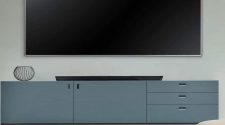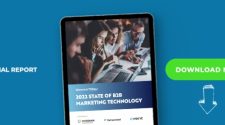K4Connect is riding a demographic wave: making technology for seniors who cope with some kind of disability while living in a community setting.
The startup provides technology that lets seniors control their smart living environments and monitor their health and wellness at 70 senior living communities. The idea is to create places where older people can age at home — with the help of technology — while still enjoying the perks of living in a community, thanks to partnerships with services like Lyft, Grubhub, and others.
This future is upon us. The U.S. Census Bureau projects the number of people in the U.S. aged 65 or older will grow to 95 million by the year 2060 and comprise nearly a quarter of the population. In fact, 10,000 people turn 65 each day in the United States.
I spoke with Derek Holt, president and chief operating officer of K4Connect, in an interview.
Here’s an edited transcript of our conversation.
Above: Amazon’s Alexa is one way to simplify tech for older people.
Image Credit: K4Connect
VentureBeat: Tell us about your background.
Derek Holt: I’ve been with K4Connect now for four years, since just a little bit after our founding. Prior to that, I spent a decade at IBM. I started as a software engineer, and eventually ran about a $350 million portion of their software group business through the early 2000s. In 2011, I was recruited by Steve Case of AOL fame, and another guy, Scott Case, no relation, but Scott was one of the cofounders of Priceline. I moved to [Washington] D.C. to work on a public/private partnership called Startup America with the Obama administration. I’ve been in technology startups ever since.
Startup America was really interesting. The thesis was, coming out of the financial crisis, starts were down. The new business startup rates are still at 30-year lows right now. Then and now, 72-75% of all venture capital goes to just three states – California, New York, and Massachusetts. Our thesis was there could be interesting entrepreneurial ecosystems in all parts of the country, focused on all different sectors. That’s what we drove to do.
VentureBeat: We did a fair amount of that with our Blueprint conference that travels around.
Holt: That’s right. I’m very familiar. Obviously, Steve Case has continued his Rise of the Rest efforts, both investing and also shining a bright light on entrepreneurship in non-traditional markets. Revolution and Rise of the Rest Fund are actually investors in K4Connect.
VentureBeat: How did you segue into K4Connect?
Holt: Interestingly enough, I had actually met Scott Moody through Startup America. Scott is a serial entrepreneur. His last company was called AuthenTec, in Melbourne, Florida. They were in the fingerprint space, a semiconductor company. They went public in 2007 and were ultimately acquired by Apple in 2012. They eventually became the Touch ID in the iPhone 5s, I think it was. Scott and I met each other and we both had roots in the North Carolina area. When I was looking to move back from Washington D.C., he was just starting K4Connect. The rest is history.
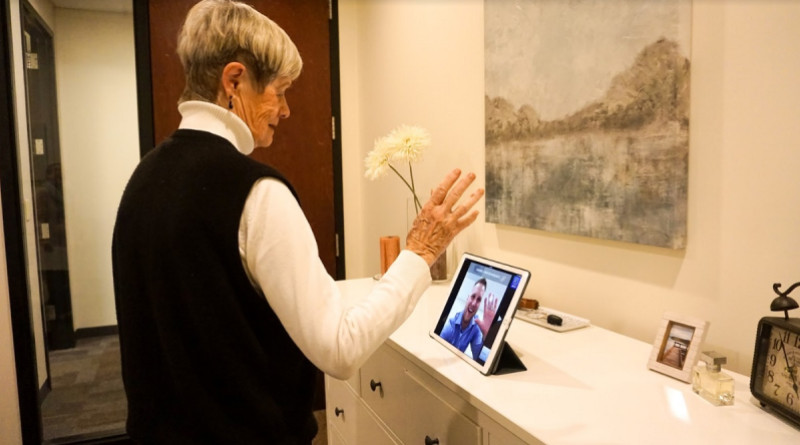
Above: K4Connect helps older people communicate.
Image Credit: K4Connect
VentureBeat: When I went to the last couple of CES shows, I complained that I didn’t see any tech that was helpful for seniors. I was paying attention because my mother has dementia. We’ve since moved her into assisted living. There were so many things I tried to get her to use that she just couldn’t figure out. Did you have the same sort of experience going into this?
Holt: It’s interesting. We all know folks that age. We were raised by them, or we had grandparents or parents. It’s an industry that, I’m almost embarrassed to say, I didn’t pay a lot of attention to. When I was an engineer in my 20s and 30s, we tend to build things for ourselves. That’s the story of Silicon Valley. We’re building technology solutions that appeal to us.
Broadly, we saw this opportunity where this technology should be making a huge difference in the lives of older adults. You could argue that this should be more of a utility for an older adult than it would be for a next-generation millennial. But ultimately there were some barriers. A lot of what we do at K4Connect is look at the technology that’s out in the marketplace and make it accessible. We make it integrated. We support it. We provide training around it. We make it easier for older adults to get over that adoption curve. In some regards, that’s been our bread and butter, to create this integration layer and then this user experience that’s unique for this particular audience.
VentureBeat: What are some specific technologies that you’re working around? My mother could not figure out how to use an iPhone. Everyone talks about how simple it is to use a smartphone, but she just had no clue.
Holt: Whether it’s visual user interfaces, or even voice, we study what the baseline is for a particular audience and then work to make it easier. If you go back to the first iPhone, you may recall they had a very skeuomorphic design. That was intended to help people move from physical to digital. It’s flattened out over the last decade. But if you’ve never picked up an iPhone before 2019, boy, you skipped a bunch of generations of teaching us how to use a touch interface.
Some specific areas we’re focused in on — number one, obviously, is the ability to access and engage with those types of user interfaces. The smart home has been really big. Think responsive smart homes, devices all integrated together that help folks live more independently within whatever life phase they’re in today. Connected wellness is a hot area. All the fitness trackers that 20-year-olds are using to track their steps, frankly, they have much more benefit and are much more critical for older adults. You see that wave of new connected wellness devices emerging. Social as well, just staying connected with loved ones.
Our bread and butter, again, is tying all those things together. Whether it’s made by Company A or B, whether it speaks Bluetooth or Wi-Fi, one of the biggest barriers we see for older adults — and frankly everyone — is that do-it-yourself doesn’t work. We’re providing that kind of enterprise integration and security and support to make it easier to adopt solutions, rather than just point products.
VentureBeat: What are some observations you’ve made about things that the elderly have trouble with when it comes to using tech?
Holt: Some of it we’ve touched on. There are some of these early adoption challenges. One, there’s a general misconception that this is going to be hard to use, or I could never do that. There’s a fear of it not working. If you or I download an app and it doesn’t work, we might delete it and redownload. Someone who’s not used the technology before might think it’s their fault, put it down, and never use it again.
We’ve had to work through a lot of those. We’ve hired, if you look at our company—we’re about 60% engineering, but the rest of the company is hiring folks from the aging services or senior living industries. We try to bring those thought processes together to help remove those barriers. But definitely the user experience type of stuff, and then the other big one is just — you almost need a computer engineering degree today to turn your house into a smart home. I do it because I enjoy getting to work on my home, but that’s a barrier for a large percentage of the population. A lot of what we focus on is ‘Don’t worry about the wireless protocol, don’t worry about who made it.’ We’ve built out patented technology that makes it all integrate together. We happen to be deploying that in the senior space, but we’re doing some novel things in the mass market in terms of connecting smart devices seamlessly, no matter the protocol.
VentureBeat: This seems like it’s not a one-company undertaking.
Holt: No, for sure. Somebody brought this up to me recently. I’m a personal believer that there’s not enough venture capital and not enough startups focused on this space. I know that’s a little counterintuitive, because obviously we want to be successful, but really, we believe there’s a huge opportunity for impact and there are just not enough companies. There are more today than when we started, but when you look at 10,000 people turning 65 every day, moving from 8.5% of the global population to almost 17% in the next 30 years, we need a lot more focus on this.
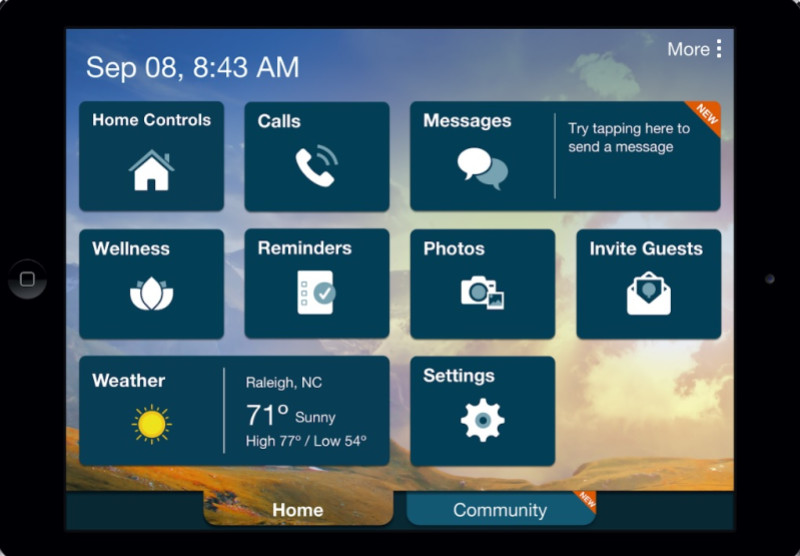
Above: K4Connect tries to simplify life for seniors.
Image Credit: K4Connect
VentureBeat: This year’s CES seemed like it had a lot of solutions for the elderly. Some of those companies are crossing that threshold of being able to do blood pressure on your wrist with a wearable, things like that.
Holt: CES actually has a separate group. The formal name of it escapes me, but it’s focusing on technology for older adults and individuals living with disabilities. It’s very much aligned with what we’re working on. They obviously have great aggregation and communication. They can shine a big spotlight. We’re big fans of the work they’re doing.
The interesting philosophical part, and we have our beliefs, but the question I still have is, ‘Do we really require unique hardware for older adults, or is the world that we live in really about — the iPad is just a piece of glass, and it needs to be about creating software and user experience things that are unique for this generation?’ Because Apple and Samsung and others are going to innovate at such scale and such speed around the physical devices. I believe there’s a huge opportunity to leverage those, tie them together, and make them more accessible to this generation. Hardware is hard, as you know.
VentureBeat: What sorts of new tech make you more hopeful?
Holt: We’ve seen, honestly — we’re now working with more than 100 communities, tens of thousands of older adults, and we’re excited about the impact smart home and responsive smart home are having. It’s crossing that novelty to utility threshold. Voice has been huge in this market. It’s really interesting. I grew up in the personal computer age and so I still find myself defaulting to a keyboard and a mouse or a touch pad. It’s just how I was introduced to technology. The next generation is all about touch and mobile. Now, if you look at the current generation, the voice stuff is hitting. If you’re an older adult who’s never used this technology, you might skip those other input models and go right to voice. That’s been interesting to see.
We have assisted living communities where we’ve had 85% adoption rates around voice — daily and weekly active user types of stuff. It’s astonishing how that becomes a utility. We’re excited about voice, excited about smart home, and we’re in the early innings of the connected wellness stuff. We’re starting to see some really interesting things happen on the wrist. That’s going to be a big area, as well.
VentureBeat: Another interesting trend from the last CES was people talking about technology for caregivers. They’re the ones doing all this work. They’re the system integrators, I guess. What sort of thinking is going into that?
Holt: We started — our first product in the market is called K4 Community. We sell that to senior living communities. There’s about 25,000 of these. There’s never been more of them under construction in the history of the U.S., because you have this big boomer population coming. Those folks are very forward-thinking. They understand care and community. But they’ve been broadly void of technology. We focused there.
All of our solutions are helping the residents — what we call our members, older adults. But all of those systems, whether it’s smart home or social or connected wellness, are throwing off data that helps caregivers do a better job of communicating, of understanding needs, of proactively engaging with residents to ensure that they’re having an optimal experience and are getting the engagement they need. We will then move that into the home. Ultimately, while it’s 25,000 communities, it’s only about 4% of the older adult population that live in communities. What role does this technology have in helping folks live in their own homes? Whether they have a family caregiver or a professional caregiver that stops by every once in a while.
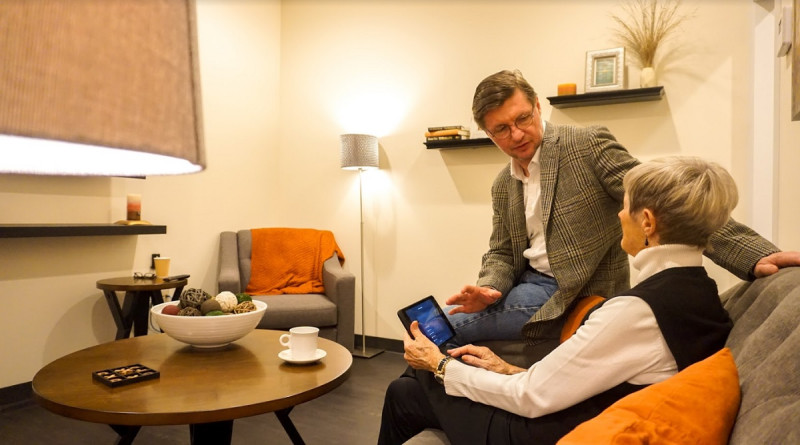
Above: K4Connect helps seniors connect.
Image Credit: K4Connect
VentureBeat: What are some things that are worth tracking out there? I don’t know if CES has an organization or sub-organization there.
Holt: They do, and so — they have a sub-group, and they even do some direct investments in companies. They’re broadly focused on facilitating focus and interest. There are others. The AARP has done some interesting things around innovation. You’re actually, for the first time, seeing some senior living communities that have a side entity that’s a center for innovation in wellness. It’s looking at everything from the stuff you’re talking about for us to companies doing VR training for staff members so they can get into the body of those that they’re caring for. They can understand what it’s like to live with dementia or what it’s like to have a stroke, those sorts of things. You’re seeing a lot of that innovation across a lot of the categories you probably already cover in the mass market. It’s just applied in a different way.
When I was at Startup America, we started working with CES on what they call Eureka Park. The first Eureka Park, I want to say we only had 50 startups. Now that’s become a really hot area within CES. Hopefully, we’ll be able to help them do the same thing with the older adults and individuals with disabilities spaces.
VentureBeat: I saw that the Cable Labs folks did a very nice video about what technology could look like in the future for older people. I wondered what kinds of visions are out there summing up how this would all ideally work.
Holt: It’s funny. I’ve seen some of these things, and I think they’re great. They’re aspirational views. But, as you know, in the technology world most of these revolutions happen very evolutionarily. When we zoom out and look over a 10- or 15-year horizon, things have dramatically changed, but as you live day to day, week to week, month to month, they’re much smaller increments that add up over time.
I think a lot of what you’re seeing is this surge around what the future of a senior living community looks like. The last 15 to 20 years have been primarily architectural enhancements, physical building changes. You’re now starting to see technology change the way that residents interact with services, interact with their home, and interact with one another. You’re going to have the baby boomers come into the market. I don’t think you can build enough senior living communities.
Most people have always preferred to live at home if they can, though, if they’re able to. What technology is going to be there to help them do that, but also help family members and caregivers care for more people more effectively, because they have access to data and a better understanding of needs?
VentureBeat: The economic motivator seems to be strong enough now. The boomers are getting old and the market is ripe. There’s a lot of opportunity if a company hits this demographic.
Holt: The market is maturing. There’s also a lot of other tailwinds. While on a smaller base, this demographic is the fastest-growing adopter of smartphones and tablets, according to Pew. They’re the fastest-growing adopters of high-speed internet. That’s because they’re the last adopters. They have a smaller base. But you have some of this infrastructure, the connectivity, the access to technology that now enables you to start to think about how to deliver new services.
On a personal note, and I think this applies to everyone in our company, we feel very lucky. We have the ability to work for a high-growth venture-backed company that is fun and exciting and doing really innovative work. We just filed our 25th or 26th patent. But we also get to come to work every day and work on things that will improve lives. Not just for older adults, which is our primary focus, but for family members and other caregivers. Those are challenging jobs and very important jobs. We believe that we can make life simpler, healthier, and happier for that whole ecosystem. It’s a rare opportunity to be able to do good while you’re doing well.



